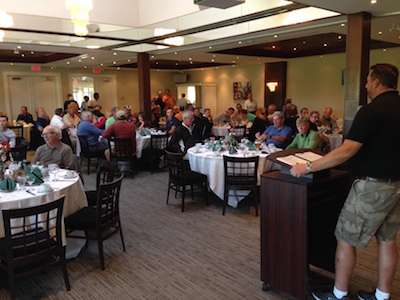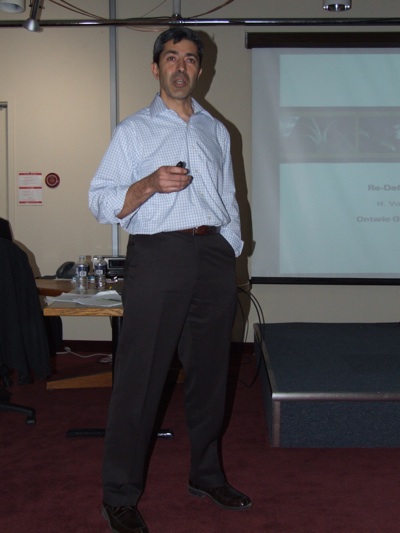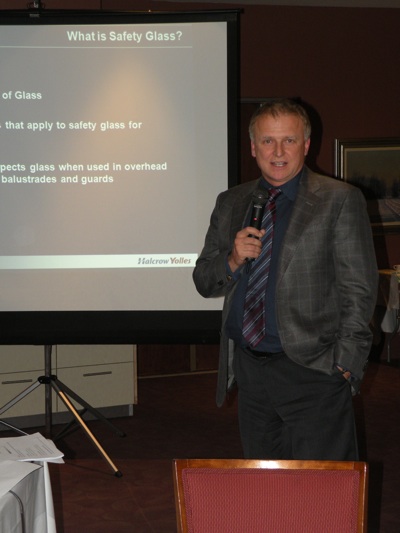
 NEWS HIGHLIGHT
NEWS HIGHLIGHT
OGMA, CSC discuss glass safety
The Ontario Glass and Metal Association and Construction Specifications Canada discussed the hot topic of safety glass at their biannual joint meeting Dec. 6 at the Toronto Skating, Curling and Cricket Club.
Dec. 7, 2011 – The Ontario Glass and Metal Association and Construction
Specifications Canada discussed the hot topic of safety glass at their
bi-annual joint meeting Dec. 6 at the Toronto Skating, Curling and
Cricket Club. The record crowd of over 100 listened to a presentation by
David Thompson and David Wittenberg of Halcrow Yolles before
participating in a lively discussion of safety glass characteristics,
building codes and engineering standards.
Alumicor's Steve Gusterson, chair of the CSC Toronto Chapter and director-at-large for OGMA, hosted the evening. Attendees enjoyed cocktails followed by an excellent buffet dinner in a cozy room with large windows overlooking young skaters on the club's ice surface.

|
|
|
Gusterson said he was pleased to see such a large turn-out.
|
Wittenberg started the educational component of the evening with a review of the various kinds of safety glass and their characteristics. Wittenberg is a structural designer who works in the Structural Glass and New Facade department of Halcrow Yolles. He has worked on such projects as a glass pedestrian bridge in the lobby of the Ritz Carleton hotel in Toronto, a glass pedestrian bridge and roof at The Core shopping centre in Calgary and The Ledge, an observation deck on the Willis Tower in Chicago. Wittenberg pointed to three common causes of failure in safety glass: improper support, poor interlayer materials and nickel sulfide inclusions. He made the important point that correct compression of glass is critical to its strength, and discussed the various factors engineers should take into account when designing overhead structures, balustrades and entrances from glass.
 |
|
|
Thompson encouraged attendees to adopt best practices voluntarily before they get imposed by regulators.
|
Next, Thompson discussed mitigating risk in glass construction. Thompson is a 34-year veteran of the construction industry starting in architectural design and moving to building envelope engineering. He oversaw construction of the Willis Tower observation boxes and has worked on glass building envelope projects on three continents. Thompson stressed that glass is an old and very desirable building material. He feels the greatest mistake building engineers make is to fail to consider the post-breakage performance of their glass structures. While tempered glass may be the strongest kind of glass, heat-strengthened glass may be preferable in some applications because it tends to break into larger shards which might retain some structural integrity and stay in place after breaking. He questioned whether single-pane tempered glass could even be properly called safety glass, saying he always used laminated and heat-soaked products when his projects called for tempered glass.
Thompson quashed the rumour that cheap Chinese glass with nickel-sulfide inclusions was responsible for the bad press glass construction has been getting in Toronto lately. He said he had seen "no evidence" that Chinese glass was involved in these problems, and noted that nickel sulfide is a rare problem, but one that can pop up anywhere, in any glass product of any price. He said that while heat soaking provides an extra degree of confidence, there is debate as to how effective it really is.
Finally, Thompson called for the glass and construction industries to become educated about glass and glass construction and adopt higher design standards to avoid becoming regulated by codes. "I'm concerned when I hear there are emergency standards meetings in Toronto," he said. "If we don't take the initiative as designers we will be left with glass in steel frames. Glass is a great building material and one we are only scratching the surface in developing."
In the subsequent discussion period the point was made that Canadian standards have lagged American standards significantly because Canadian standard-making is funded by taxpayers while American ASTM standards are developed by volunteers. The lower cost of U.S. standard development allows for more frequent updates. The ASTM standard was last updated in 2009, while the CSA standard was last updated in 1989.
Related links
OGMA
CSC Toronto
Glass condos "throw-away buildings": CBC report
ASTM
CSA
Print this page
Leave a Reply